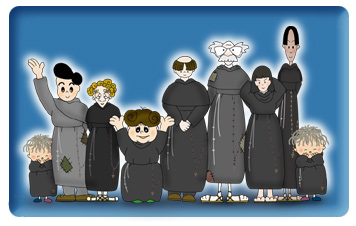
축일 : 1월30일
성녀 히야친타 마리스코티
Santa Giacinta Marescotti Religiosa, TOR
Vignanello (VT), 1585 - Viterbo, 30 gennaio 1640
Etimologia: Giacinta = dal nome del fiore
Saint Hyacintha of Mariscotti
Born : 1585 near Viterbo, Italy
Died : 1640 at Viterbo, Italy of natural causes
Beatified : 1 September 1726 by Pope Benedict XIII
Canonized : 24 May 1807 by Pope Pius VII

히야친타는 1585년 비테르보에서 태어나 어린 나이에 3회에 들어왔다.
심한 질병을 앓은 후에 엄격한 보속의 생활을 하면서 이웃사랑에도 열심이었다.
1640년 비테르보에서 선종했다.
하느님, 복된 동정녀 히야친타를 당신 사랑으로 불타게 하시고
끊임없는 극기의 모범으로 세우셨으니, 그의 전구를 들으시고
저희도 눈물로 죄를 뉘우치고 기쁜 마음으로 당신 사랑 안에 머물게 하소서.
성부와 성령과 함께 천주로서 영원히 살아계시며 다스리시는 성자
우리 주 예수 그리스도를 통하여 비나이다 아멘.
((재속프란치스코회 지침서-발자취를 따라서에서)

비냐렐로의 귀족 가문에서 태어난 그녀는 비떼르보의 프란치스꼬회 수도원에서 교육을 받고,
비떼르보의 프란치스꼬 율수 3회에 입회하였다.
이때에 그녀는 히야친따라는 이름을 받고 서원하였다.
특히 그녀의 애덕은 수도원이란 한계를 뛰어넘을만큼 위대하였고,
따라서 병자와 노인, 가난한 이들에게 헌신적인 사랑을 보였다.
그녀는 55세 때에 운명하였다.
시성 선언문에는 이런 말이 나온다 :
"그녀의 고행은 자신의 삶 전체가 하나의 지속적인 기적임을 보여주고,
그녀의 사랑의 사도직은 수많은 설교보다도 영혼들을 하느님께 인도하는데 유익하였다."
(성바오로수도회홈에서)

이탈리아 비테르보(Viterbo) 인근 비냐렐로(Vignarello)의 귀족 가문에서 태어난 성녀 히야친타 마리스코티(Hyacintha de Mariscottis)는 비테르보의 성 베르나르디누스 수녀원에서 교육을 받았고, 자신과 혼담이 오가던 한 후작이 그녀의 여동생과 결혼하게 된 사건으로 크게 충격을 받았다. 이를 계기로 성 베르나르디누스 수녀원에 입회한 그녀는 히야친타라는 수도명을 받았다. 그녀는 수도생활 초기 10여 년간 여전히 사치스럽고 개인적 생활로 수녀회에 나쁜 영향을 끼쳤다. 그러다가 어느 날 중병에 걸려 고해성사를 하면서 과거를 참회하고 진정한 수도자의 삶을 살게 되었다.
성녀 히야친타의 가장 큰 덕은 애덕으로 수도원이란 한계를 뛰어넘을 만큼 위대하였다. 그녀는 병자와 노인, 가난한 이들에게 헌신적인 사랑을 보였다. 비테르보 지역에 전염병이 돌았을 때 그녀는 병자 간호에 헌신하였고 두 개의 자선 단체도 설립하였다. 그러다가 1640년 1월 30일 비테르보에서 세상을 떠났다. 성녀 히야친타는 1726년 9월 1일 교황 베네딕투스 13세(Benedictus XIII)에 의해 시복되었고, 1807년 5월 24일 교황 비오 7세(Pius VII)에 의해 시성되었다. 이때 시성 선언문에 이런 말이 나온다. “그녀의 고행은 자신의 삶 전체가 하나의 지속적인 기적임을 보여주었고, 그녀의 사랑의 사도직은 수많은 설교보다도 영혼들을 하느님께 인도하는데 유익하였다.”
(가톨릭홈에서)
*파티마의 복녀 히야친타 축일: 2월20일, 게시판1626번.
*폴란드의 사도 성 히야친토 축일: 8월17일.게시판1319번.
*비테르보의 성녀 로사 축일:9월4일(3월6일), 게시판1348번, 1647번,
☞http://home.catholic.or.kr/gnbbs/ncbbs.dll/chinchang

율수3회(Third Order Reguar)의 분리
13세기 말경을 거치면서 3회원들 중에서는 은둔생활을 함으로써 수도생활의 형태를 지니는 공동체가 생기게 되었다. 이에 1295년 교황 보니파시오 8세는 북독일에서 공동생활을 하는 회개의 형제들에게 성무일도를 바치는 경당을 가질 수 있다는 허락을 해주었다. 1323년 교황 요한 22세는 <Altissimo in divinis>(공경하올 지극히 높으신 분)이라는 칙서로 이들의 공동생활을 공식적으로 인준하였다. 이로써 재속3회와 율수3회가 법적으로 분리되기에 이르렀다.
이처럼 재속3회 안에서 수도생활을 하려는 단체들이 많아져 보다 엄격한 조직과 규정의 통일성이 요구되었다. 그중 마르시아노의 안젤리나(Angelina)는 1397년 프란치스코 3회의 회칙을 지키면서도 엄격한 은둔생활을 하는 여성들만을 위한 공동체를 세우게 되었다. 이와 비슷한 5개의 여자 수도회가 생기자 안젤리나는 총장으로 일하게 되고 교황에게 인준을 신청했다. 그녀는 여성들만을 위한 율수3회의 창설자로 여겨진다.
남자들의 공동 생활도 발전해 갔다. 1401년 1월18일 보티파시오 9세는 남자 공동체에서 자신들의 총장을 선출하고 수도서원을 발할 권한을 주면서 남자수도3회를 인가하였다. 1413년에는 요한 22세 교황이 마려해준 규칙에 따라 가난,순명,정결 서원을 하였으며, 성당과 회색수도복, 숙소등이 마련되었다. 또한 서원 전에 1년의 수련기를 갖게 되고 정기적인 회합 및 자신들의 시찰자를 선출하게 되었다.
1443년에 리제(Liege)의 주교는 그동안 지역적으로 생활하던 수도공동체가 제퍼런(Zepperen) 공동체를 모원으로 가지도록 요구하였고 소집하였다. 이리하여 하나로 일치된 남자들의 공동체도 구성되었다. 1447년 니콜라오 5세 칙서<Pastoralis officii>로 이탈리아에 있는 모든 3회 은둔 공동체는 율수3회로 통합 할 것을 명하였다.
1521년 교황 레오 10세는 니콜라오 회칙(1289년)에 성대서원을 할 수 있는 10개의 장을 첨가한 회칙을<Inter coetera> 칙서로 인준해 주었다. 이로써 재속3회의 생활 양식과 다른 수도서원의 생활 양식을 사는 율수3회는 비로소 법적으로나 생활양식으로나 재속 3회와 완전한 분리가 이루어졌다.
(김창재다미아노ofm, 강의록 간추린 프란치스칸 역사, 2006프란치스칸 영성학교, 83-84쪽에서)
율수3회(Tertius Ordo Regularis, T.O.R.)
13세기 부터 재속 3회 내에서 수도 생활을 하려는 사람들이 많아졌다.
이들은 단체를 구성하고 자선사업을 하며 공동생활을 하기 시작했다.
1413년 교환 요한 22세가 칙서를 보내서 총회를 가질수 있도록 하였다.
1회와 똑같은 서원을 하며, 1회와 3회의 이상을 결합한 고유의 회칙을 갖고 있다.
1회 세가족과 함께 재속프란치스코회의 영적. 사목적 보조를 한다.
우리나라에는 아직 진출하지 않았다.
성 프란치스코의 영적 가족들
1회: 작은형제회(O.F.M.).꼰벤뚜알프란치스코수도회(O.F.M.conv.),카푸친작은형제회(O.F.M.cap.)
2회: 클라라회(O.S.C.)
3회: 재속프란치스코회(O.F.S.), 율수3회(T.O.R.), 수도 3회
(재속프란치스코회홈에서)
율수3회의 성인,복자들...
* 성녀 히야친타 마리스코티 동정녀(+1640) TOR 축일 :1월30일(인창동성당게시판1593번)
* 카우프베론의 성녀 마리아 크레센시아 호세 동정녀(+1744) TOR 축일 4월5일 (인창동성당 게시판2092번)
* 복자 요한 시니 데 파체 증거자(+1340) TOR 축일 11월12일 (인창동성당 게시판2089번)
* 칼타지로네의 복녀 루치아 동정녀(+1400) TOR 축일 9월26일 (인창동성당 게시판2090번)
* 로이터의 복녀 엘리사벳 동정녀(+1420) TOR 축일 11월25일 (인창동성당 게시판2091번)
* 마르시아노의 복녀 안젤리나(+1435) TOR 축일 7월13일 (인창동성당 게시판1272번)
* 피렌체의 복녀 안토니아 동정녀(+1472) TOR 축일 2월28일 (인창동성당 게시판1639번)
* 복자 요한 예로니모 요(토레스)순교자(+1632) TOR ?
* 복자 죠르지오 지롤트 순교자(+1792) TOR 축일 9월2일 (인창동성당 게시판2072번).........

변화
우리가 원치 않는 일을 하도록 강요당할 때, 두 가지로 반응할 수 있다.
하나는 힘껏 저항해서 자신과 주위 사람들을 곤란하게 만드는 것이고,
다른 하나는 일단 그것을 받아들인 후 최선의 상황으로 바꾸어 가는 것이다.
성녀 히야친타는 전자를 선택했다.
그는 막내 여동생이 자기보다 먼저 결혼한 것을 끝내 받아들이지 못했다.
보다 못한 가족들이 그를 프란치스코 수녀원에 강제로 입회시켰는데,
그는 그곳에서도 제멋대로 생활함으로써 주위 사람들에게 크나큰 어려움을 주었다.
그렇게 지낸 지 10년쯤 되던 해에 히야친타는 심각한 질병을 앓게 되었는데,
이를 계기로 자신의 모습을 되돌아보게 되었고,
삶의 방법을 바꾸어 마침내는 자기 수련과 자선가의 모델이 되었다.
성녀 히야친타는 ‘아무리 늦어도 변화는 가능하다.’라는 것을 보여 주었다.
변화는 결코 쉽지 않다.
철저한 자기 성찰이 선행되어야 하기 때문이다.
자신의 영혼을 깊이 들여다보면 그 안에 이기심, 교만, 탐욕처럼 온갖 부정적인 것들이 있음을 발견하게 된다.
그러나 그런 것들이 존재하지 않는 것처럼 가장하기보다는 억지로라도 그것들을 직시해야 한다.
자신의 어두운 면을 인정하는 것이야말로 변화의 첫 단계다.
성녀 히야친타처럼 그것을 직시하고 인정할 때,
우리의 어두운 내면에 진리와 희망, 그리고 사랑의 빛이 채워질 수 있다.
나는 변화를 두려워하는가?
변화하지 않고 이대로 산다면 어떻게 될까? 자신을 정직하게 성찰하자.
(까리따스수녀회홈에서)

♬Fratello sole,sorella luna-Claudio Baglioni
Fratello Sole, Sorella Luna
Dolce sentire come nel mio cuore
ora, umilmente, sta nascendo amore.
Dolce capire che non son piusolo
ma che son parte di un’immensa vita,
che generosa risplende intorno a me:
dono di Lui, del Suo immenso amor.
Ci ha dato il cielo e le chiare stelle,
fratello Sole e sorella Luna;
la madre Terra con frutti, prati e fiori
il fuoco, il vento, l’aria e l’acqua pura,
fonte di vita per le Sue creature:
dono di Lui, del Suo immenso amor,
dono di Lui, del Suo immenso amor.
Sia laudato nostro Signore
che ha creato l’universo intero.
Sia laudato nostro Signore
noi tutti siamo Sue creature:
dono di Lui, del Suo immenso amor,
beato chi Lo serve in umilta
Santa Giacinta Marescotti Religiosa
30 gennaio
Vignanello (VT), 1585 - Viterbo, 30 gennaio 1640
Nasce nel 1585, nel castello di Vignanello (Viterbo), Clarice, la figlia del principe Marcantonio Marescotti. È nobile, bella, sogna un matrimonio degno del suo casato. Si presenta anche il partito giusto nella persona di un giovane marchese. I genitori, però, preferiscono sistemare per prima la sorella minore Ortensia. Grande è la delusione di Clarice che reagisce rendendo la vita impossibile a genitori e parenti. Da parte sua il principe Marcantonio costringe la figlia a entrare nel convento delle clarisse. Non si arrende facilmente la giovane. Si fa terziaria francescana di modo da non essere costretta alla clausura, vive a lungo in un appartamentino ben arredato, fa di tutto per distinguersi dalle altre religiose. Poi si ammala seriamente e il confessore la scuote. Giacinta, che ha ormai 30 anni, comprende che non conviene vivere di rancore e repentinamente decide di cambiare.
Chiede perdono alle consorelle, si priva del superfluo, si sottopone a severe penitenze. Nella sua stanza, ormai, l’unico ornamento è una grande croce che in continuazione le ricorda che «Gesù, il mio amore, è stato Crocefisso». Medita di continuo sui dolori della passione, è devota dello Spirito Santo, lo invoca di continuo perché accresca il suo amore. L’amore di Dio trascina con sé anche l’attenzione per il prossimo. Ai più poveri dona il suo cibo, le vesti, le coperte del letto. Poi inizia a chiedere aiuto agli amici di un tempo per sostenere due importanti opere di carità: I Sacconi, infermieri, per l’assistenza agli ammalati, gli Oblati di Maria per la cura delle persone anziane. Morì a Viterbo nel 1640, subito venerata come santa dalle consorelle e dai fedeli.
Etimologia: Giacinta = dal nome del fiore
Martirologio Romano: A Viterbo, santa Giacinta Marescotti, vergine del Terz’Ordine regolare di San Francesco, che, dopo quindici anni passati tra vani piaceri, abbracciò una vita durissima e istituì confraternite per l’assistenza degli anziani e per l’adorazione della santa Eucaristia.
Ascolta da RadioRai:
Sogna un marito, non il monastero. Si chiama Clarice, è molto bella e ha sott’occhio un giovane marchese Capizucchi, ottimo partito per una figlia del principe Marcantonio Marescotti, alta aristocrazia romana. E il principe, infatti, gli dà volentieri in moglie una figlia. Ma non è Clarice. E’ Ortensia, la più giovane. Dopodiché Clarice diventa il flagello della casata, insopportabile per tutti. Una delusione simile può davvero inasprire chiunque, ma forse le accuse sono anche un po’ gonfiate per giustificare la reazione del padre, che nel 1605 la fa entrare nel monastero di San Bernardino a Viterbo, dalle Clarisse, dove c’è già sua sorella Ginevra.
Qui lei prende il nome di Giacinta, ma senza farsi monaca: sceglie lo stato di terziaria francescana, che non comporta clausura stretta. Vive in due camerette ben arredate con roba di casa sua e partecipa alle attività comuni. Ma non è come le altre. Lo sente, glielo fanno sentire: un brutto vivere. Per quindici anni si tira avanti così: una vita "di molte vanità et schiocchezze nella quale hero vissuta nella sacra religione". Parole sue di dopo.
C’è un “dopo”, infatti. C’è una profonda trasformazione interiore, dopo una grave malattia di lei e alcune morti in famiglia. Per suor Giacinta cominciano ventiquattro anni straordinari e durissimi, in povertà totale. E di continue penitenze, con asprezze oggi poco comprensibili, ma che rivelano energie nuove e sorprendenti. Dalle due camerette raffinate lei passa a una cella derelitta per vivere di privazioni: ma al tempo stesso, di lì, compie un’opera singolare di “riconquista”. Personaggi lontani dalla fede vi tornano per opera sua, e si fanno suoi collaboratori nell’aiuto ad ammalati e poveri. Un aiuto che Giacinta la penitente vuole sistematico, regolare, per opera di persone fortemente motivate. Questa mistica si fa organizzatrice di istituti assistenziali come quello detto dei “Sacconi” (dal sacco che i confratelli indossano nel loro servizio) che aiuta poveri, malati e detenuti, e che si perpetuerà fino al XX secolo. E come quello degli Oblati di Maria, chiamati a servire i vecchi.
Nel monastero che l’ha vista entrare delusa e corrucciata, Giacinta si realizza con una totalità mai sognata, anche come stimolatrice della fede e maestra: la vediamo infatti contrastare il giansenismo nelle sue terre, con incisivi stimoli all’amore e all’adorazione per il sacramento eucaristico. Non sono molti quelli che la conoscono di persona. Ma subito dopo la sua morte, tutta Viterbo corre alla chiesa dov’è esposta la salma. E tutti si portano via un pezzetto del suo abito, sicché bisognerà rivestirla tre volte. A Viterbo lei resterà per sempre, nella chiesa del monastero delle Clarisse, distrutta dalla guerra 1940-45 e ricostruita nel 1959. La sua canonizzazione sarà celebrata da Pio VII nel 1807.
Autore: Domenico Agasso
Fonte:
_______________________
Aggiunto il 2001-02-01
Saint Hyacintha of Mariscotti
Memorial
30 January
Profile
Italian nobility. Educated in a Franciscan convent. Franciscan tertiary at Saint Bernardine's convent in Viterbo, Italy for ten years, though with no real enthusiasm; she used her personal funds to insure comfortable lodgings, and none of the privations of the other tertiaries. A serious illness caused Hyacintha's confessor to bring her Communion, which allowed him to see her rooms for the first time. Scandalized at the life she provided herself, the priest told her to live more humbly. Hyacintha took his advice, became humble in her food and dress, did the most menial work in the convent, and replaced her bed with a few bare boards. She became an exceptional mistress of novices, and developed a special appeal for "those who are despised, who are devoid of self-love and who have little sensible consolation." Over the years she developed a special devotion to the sufferings of Christ and, by her penances, became an inspiration to the sisters in her convent. Foundress of the Sacconi or Oblates of Mary, dedicated to working with the aged poor
Born
1585 near Viterbo, Italy
Died
1640 at Viterbo, Italy of natural causes
Beatified
1 September 1726 by Pope Benedict XIII
Canonized
24 May 1807 by Pope Pius VII
January 30
St. Hyacintha Mariscotti
1585-1640
St. Hyacintha, born in 1585, belonged to a wealthy and prominent family. Her father was Count Antonio of Mariscotti, her mother descended from the princely Roman family of the Orsini.
After her younger sister had been given in marriage, the disappointed Clarice, as Hyacintha was then called, entered the convent of the Tertiaries at Viterbo, but apparently only as a secular Tertiary. She permitted herself to be supplied with all sorts of things by way of eatables and articles of dress which enabled her to enjoy quite an agreeable and comfortable existence. Her rooms were furnished with much worldly apparatus. The spirit of mortification and of penance with which every Tertiary ought to be equipped was in no wise discernible to her.
Then it happened that she was afflicted with a strange illness, and her confessor was obliged to go to her rooms to administer the sacraments to her. When he saw the worldly and frivolous objects in her cell, he sharply reproved the sick sister. Following her confessor’s advice, she afterwards went to the common refectory and there, with a rope around her neck, begged forgiveness of her fellow sisters for the scandal she had given them. However, it was only after she had invoked the aid of St. Catherine of Siena, that she dispossessed herself of all frivolous and unnecessary objects, and thereupon resolutely entered upon a life of heroic virtue.
She began to lead a very penitential life, in which she persevered unto the end. She went barefoot, wore an old habit that had been discarded by another sister, and performed the lowliest and most trying tasks. She ate only inferior food with which she mixed bitter herbs. Her bed consisted of a few bare boards, on which there was but a single blanket; a stone served as her pillow. She fostered a special devotion to the sufferings of Christ; and in memory of them, she subjected herself to special austerities on Fridays and in Holy Week. She also entertained a filial love for Mary, the Mother of Mercy, who sometimes appeared to her and comforted her. Enriched by every virtue and held in great repute by her fellow sisters, she died in the 55th year of her age, in the year of our Lord 1640. Many miracles occurred at her grave for which reason Pope Benedict XIII placed her in the ranks of the blessed. In the year 1807 she was canonized by Pope Pius VII.
ON ACCEPTING REPRIMANDS IN THE PROPER SPIRIT
How fortunate it was for Hyacintha that her confessor rebuked her so severely though he knew of her distinguished descent and saw that she was on her sickbed. It is really a great charity to us if a person points out our faults to us in a becoming manner. Every man has his faults. But often we are unaware of them; self-love hides them from us and, unfortunately, those that call themselves our friends, also try to palliate them and justify them, so that we can truly say, “Those who praise me, do not love me.” Thus it is also written in Holy Scripture: “Open rebuke is better than hidden love. Better are the wounds of a friend than the deceitful kisses of an enemy” (Prov 27:5). -- Have you always counted those as your benefactors who have reprimanded you, and do you have the courage to extend this charity to others when it is seasonable?
Consider what folly it is to resent a well meant reprimand. What would have happened to Hyacintha if she had not accepted the reprimand given her by her confessor? When a person corrects you, he gives you a mark of his confidence, for evidently he regards you as virtuous enough to accept it in good par, otherwise it would be foolish to reprimand you. If you resent it, he will certainly be very careful not to correct you again; but in the end you will have to hear more severe reproaches when you stand before the judgement seat of God. Therefore do not shut the door of your heart to wholesome admonition, but be grateful to him who administers it. -- Has this been your way in the past? Do you perhaps also have the courage calmly to accept an unmerited reprimand?
Because friends that are true enough to correct us are so rare, we should be all the more anxious to profit from admonitions that are given in general. Such admonitions are given in sermons and in spiritual reading. On such occasions one is so readily inclined to refer everything that is faulty to others, or, when a reproof does strike home, to take offence at the author. It is the enemy of the soul who is back of all this and who is endeavouring to prevent our amendment. Do not let yourself be led astray by him, but rather be grateful to God, who so kindly leads us, erring sheep, back to the fold. From now on, strive to apply to yourself all the admonitions you meet with in sermons or in spiritual reading.
PRAYER OF THE CHURCH
O God, who didst transform the holy virgin Hyacintha into a sacrifice of continual mortification and love, grant through her example and intercession that we may bewail our sins and love Thee at all times. Through Christ our Lord. Amen.





